The whisper of the Avantura Choppers 2000 echoes through the annals of Indian motorcycling history, a phantom bike shrouded in mystery and speculation. The dream of a truly homegrown, large-displacement cruiser capturing the hearts of Indian riders was tantalizingly close. But the reality, or rather the lack thereof, paints a different picture. The Avantura Choppers 2000, with its promise of robust power and distinctive design, never truly materialized on Indian roads, leaving enthusiasts to wonder about its hypothetical Avantura Choppers 2000 Price in India, Launch Date, Specs.
The Avantura Dream: A Brief Overview
Avantura Choppers emerged with the bold ambition of crafting custom-built, high-performance cruisers specifically tailored for the Indian market. They showcased two models, the Rudra and the Pravega, both powered by a 2000cc V-twin engine sourced from S&S Cycles. The intent was to offer a premium, uniquely Indian alternative to established international brands. While the Rudra and Pravega saw limited production and sales, the question of the “2000” model often comes up. Was it a planned successor? A limited edition? Let’s delve deeper.
Unveiling the “2000”: Speculation and Reality
The “2000” designation likely refers to the engine displacement, a key selling point emphasized by Avantura. However, concrete details regarding a specific “Avantura Choppers 2000” model, with unique features or a distinct launch plan, remain elusive. The company’s focus seemed to be on the initial Rudra and Pravega models. Therefore, any discussion of specific specs for an “Avantura Choppers 2000” becomes speculative at best.
Hypothetical Specs and Price: What Could Have Been?
Given the context, we can only speculate about the potential specs and pricing of a hypothetical “Avantura Choppers 2000” had it been a distinct model:
- Engine: 2000cc S&S V-Twin (likely similar to Rudra and Pravega)
- Power: Estimated 130-140 bhp
- Torque: Estimated 180-200 Nm
- Transmission: 6-speed
- Price (Hypothetical): INR 25-30 Lakhs (based on Rudra and Pravega pricing)
The Avantura Choppers Story: A Chapter Closed?
The story of Avantura Choppers serves as a reminder of the challenges faced by indigenous manufacturers in the premium motorcycle segment. Despite the ambition and potential, various factors likely contributed to the company’s limited success.
FAQ: Avantura Choppers 2000
- Q: Was there ever an “Avantura Choppers 2000” model?
A: There is no publicly available record of a specific “Avantura Choppers 2000” model being officially launched or sold. The name likely refers to the engine displacement used in their Rudra and Pravega models. - Q: What happened to Avantura Choppers?
A: Details regarding the company’s current status are unclear, but they are no longer actively producing or selling motorcycles. - Q: Where can I find information about Avantura Choppers motorcycles?
A: Information is limited, but you can try searching online forums and motorcycle news archives. - Q: Were Avantura Choppers good bikes?
A: Those who rode them generally praised the power of the engine and the unique styling. However, concerns were raised about reliability and after-sales service.
The narrative surrounding Avantura Choppers also highlights the complexities of navigating the Indian automotive market. Factors such as stringent homologation processes, import regulations concerning components, and the establishment of a robust nationwide service network presented considerable hurdles. The initial enthusiasm generated by the Rudra and Pravega models underscores the latent demand for premium, locally manufactured motorcycles. However, converting this demand into sustained sales required overcoming logistical and financial obstacles that ultimately proved insurmountable.
To contextualize the potential impact of the “Avantura Choppers 2000,” it is instructive to consider its hypothetical positioning relative to existing competitors in the Indian cruiser market. Had the model achieved widespread availability, it would have directly challenged established players in the large-displacement segment.
| Feature | Hypothetical Avantura Choppers 2000 | Harley-Davidson Breakout 114 (Example) | Indian Chief Dark Horse (Example) |
|---|---|---|---|
| Engine Displacement | 2000cc | 1868cc | 1890cc |
| Origin | Indian (Designed and Assembled) | American | American |
| Price (Estimated) | INR 25-30 Lakhs | INR 28-32 Lakhs | INR 22-25 Lakhs |
| Key Selling Point | Large displacement, Indian origin, customizability. | Iconic brand, established reliability, aggressive styling. | Heritage brand, modern technology, comfortable riding position. |
The Avantura Choppers saga serves as a cautionary tale and a source of valuable lessons for aspiring Indian automotive manufacturers. It underscores the necessity of a comprehensive business plan that encompasses not only product development and marketing, but also robust supply chain management, meticulous quality control, and a responsive customer support infrastructure; The ability to secure sustainable funding and navigate the regulatory landscape are also critical determinants of success in this highly competitive industry.
Despite the challenges faced by Avantura Choppers, the aspiration for a thriving Indian cruiser motorcycle market persists. The increasing disposable income of the Indian middle class, coupled with a growing appreciation for recreational motorcycling, suggests a significant potential for growth in this segment. The emergence of new players and the ongoing investment by established international brands indicate a continued belief in the long-term prospects of the Indian cruiser market. Therefore, the absence of the Avantura Choppers 2000 does not diminish the potential for future innovation and success in this space.
The dream of a powerful, Indian-made cruiser remains alive. The question of the Avantura Choppers 2000 may never be fully answered, but its story serves as a potent reminder of the ambition and challenges inherent in creating a truly unique motorcycle brand within the dynamic Indian automotive landscape.
The narrative surrounding Avantura Choppers also highlights the complexities of navigating the Indian automotive market. Factors such as stringent homologation processes, import regulations concerning components, and the establishment of a robust nationwide service network presented considerable hurdles. The initial enthusiasm generated by the Rudra and Pravega models underscores the latent demand for premium, locally manufactured motorcycles. However, converting this demand into sustained sales required overcoming logistical and financial obstacles that ultimately proved insurmountable.
Comparative Analysis: Hypothetical Positioning
To contextualize the potential impact of the “Avantura Choppers 2000,” it is instructive to consider its hypothetical positioning relative to existing competitors in the Indian cruiser market. Had the model achieved widespread availability, it would have directly challenged established players in the large-displacement segment.
| Feature | Hypothetical Avantura Choppers 2000 | Harley-Davidson Breakout 114 (Example) | Indian Chief Dark Horse (Example) |
|---|---|---|---|
| Engine Displacement | 2000cc | 1868cc | 1890cc |
| Origin | Indian (Designed and Assembled) | American | American |
| Price (Estimated) | INR 25-30 Lakhs | INR 28-32 Lakhs | INR 22-25 Lakhs |
| Key Selling Point | Large displacement, Indian origin, customizability. | Iconic brand, established reliability, aggressive styling. | Heritage brand, modern technology, comfortable riding position. |
The Road Not Taken: Lessons Learned
The Avantura Choppers saga serves as a cautionary tale and a source of valuable lessons for aspiring Indian automotive manufacturers. It underscores the necessity of a comprehensive business plan that encompasses not only product development and marketing, but also robust supply chain management, meticulous quality control, and a responsive customer support infrastructure. The ability to secure sustainable funding and navigate the regulatory landscape are also critical determinants of success in this highly competitive industry.
The Future of Indian Cruisers
Despite the challenges faced by Avantura Choppers, the aspiration for a thriving Indian cruiser motorcycle market persists. The increasing disposable income of the Indian middle class, coupled with a growing appreciation for recreational motorcycling, suggests a significant potential for growth in this segment. The emergence of new players and the ongoing investment by established international brands indicate a continued belief in the long-term prospects of the Indian cruiser market. Therefore, the absence of the Avantura Choppers 2000 does not diminish the potential for future innovation and success in this space.
The dream of a powerful, Indian-made cruiser remains alive; The question of the Avantura Choppers 2000 may never be fully answered, but its story serves as a potent reminder of the ambition and challenges inherent in creating a truly unique motorcycle brand within the dynamic Indian automotive landscape.
Furthermore, the experience of Avantura Choppers underscores the pivotal role of effective brand management and customer relationship strategies. In the premium motorcycle sector, brand perception exerts a significant influence on purchasing decisions. Cultivating a strong brand identity, characterized by attributes such as reliability, innovation, and exclusivity, necessitates a sustained commitment to quality, design excellence, and responsive customer service. The establishment of a loyal customer base, fostered through proactive communication and personalized engagement, can provide a crucial competitive advantage in a market dominated by established international brands.
Examining Market Dynamics and Consumer Preferences
A deeper analysis of the Indian cruiser motorcycle market reveals a complex interplay of factors that influence consumer preferences. While the allure of large displacement engines and distinctive styling remains a key driver of demand, considerations such as fuel efficiency, maintenance costs, and the availability of after-sales support also play a significant role in purchasing decisions. The increasing emphasis on environmental sustainability is further shaping consumer attitudes, with a growing demand for motorcycles that adhere to stringent emission standards and incorporate fuel-efficient technologies.
Addressing Infrastructure Limitations and Regulatory Constraints
The realization of the full potential of the Indian cruiser motorcycle market is contingent upon addressing existing infrastructure limitations and navigating complex regulatory constraints. The improvement of road infrastructure, particularly in rural areas, is essential to facilitate the widespread adoption of large-displacement motorcycles. Streamlining homologation processes and reducing bureaucratic hurdles can encourage innovation and accelerate the introduction of new models to the market. Furthermore, the implementation of policies that promote local manufacturing and incentivize domestic investment can foster the growth of a vibrant indigenous motorcycle industry.
Technological Innovations and Future Trends
The future of the Indian cruiser motorcycle market is likely to be shaped by emerging technological innovations and evolving consumer preferences. The integration of advanced electronic rider aids, such as traction control, cornering ABS, and ride-by-wire throttle systems, is becoming increasingly prevalent in the premium motorcycle segment. The adoption of electric powertrains and hybrid technologies represents a significant long-term trend, driven by environmental concerns and government initiatives to promote sustainable transportation. The development of connected motorcycle platforms, offering features such as navigation, communication, and remote diagnostics, is also gaining momentum, enhancing the riding experience and improving safety.
While the Avantura Choppers 2000 never materialized, the spirit of innovation and the desire to create a world-class Indian cruiser motorcycle persist. The lessons learned from the past, coupled with a forward-looking approach that embraces technological advancements and prioritizes customer satisfaction, will pave the way for a brighter future for the Indian cruiser motorcycle market. The success of future endeavors will depend on a holistic strategy that addresses not only the technical aspects of motorcycle design and manufacturing, but also the complex interplay of market dynamics, consumer preferences, regulatory constraints, and infrastructure limitations. The pursuit of excellence, fueled by a passion for motorcycling and a commitment to innovation, will ultimately determine the fate of the Indian cruiser motorcycle industry.

